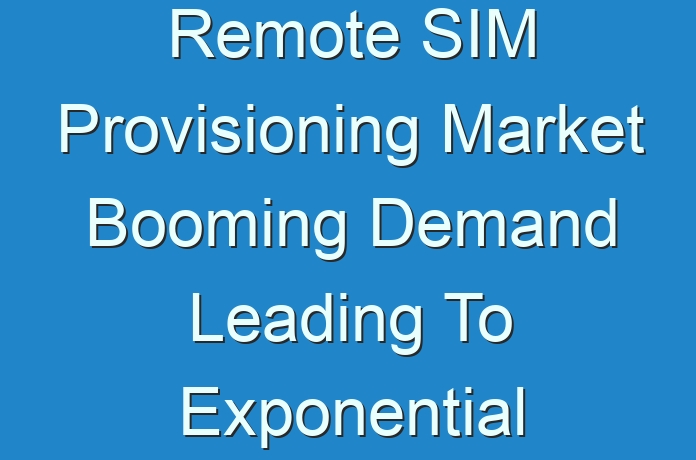
Global Remote SIM Provisioning Market: Overview
Subscriber identity module (SIM) provides secure and authenticated access to mobile networks. Remote SIM provisioning is built on existing SIM technology to support emerging technological advancements. Remote SIM provisioning can be updated over-the-air (OTA) and it stores one or more network operator profiles. It enables swapping and switching from one network provider to another without physically changing the SIM.
It allows mobile operators to provide reliable, scalable and secure connectivity. It unites the operator, SIM suppliers with a single specification to avoid fragmented and incompatible technical solutions. It assists selection and download of mobile network operator profile with fast activation of services.
Global remote SIM provisioning technology is a step towards digitization. It allows end users to centrally manage all of their connected devices. Few of these include connected cars, M2M devices and consumer electronics such as, headsets, wearable electronics and tablets.
Planning to lay down future strategy? Perfect your plan with our report sample here https://www.transparencymarketresearch.com/sample/sample.php?flag=S&rep_id=11510

Global Remote SIM Provisioning Market: Drivers
Mobile connected devices are expected to increase the remote SIM provisioning market as currently mobile network is being used to connect various types of devices/products such as intelligent connectivity of commercial vehicles to access navigation, automated reading of utility meters and home security and assisted living. Need for simplified remote management of relevant subscribers in M2M devices is the need of hour and hence remote Sim provisioning fulfills the gap. The GSMA Embedded SIM Specification provides a standard mechanism for remote SIM management and provisioning of M2M devices connecting over-the-air (OTA) which includes seamless mobile connections for all types of connected machines. It enables switching from one operator subscription to another thereby reducing the possible theft through “SIM card integration” within device.
The flexibility offered by remote SIM provisioning enables M2M device manufacturers to achieve high production volumes efficiently. Initially designed for the automotive sector, the GSMA Embedded SIM Specification has found wide adoption and became the main approach for embedded SIMs in M2M devices.
The drivers for global remote SIM provisioning market are limitation of traditional SIM such as manual SIM card switching for B2B customers, optimize manufacturing process (by giving global product with local provisioning when deployed in the field), profile interoperability and ability to manage M2M devices located remotely.
Global Remote SIM Provisioning Market: Opportunities
The opportunities for global remote SIM provisioning market are emerging technology such as M2M connected devices, consumer electronics sector and IoT (Smart appliances, variety of future data-sensor applications and Wearable gadgets collectively referred as the Internet of Things). Automotive market is expected to contribute to the remote SIM provisioning market growth as integration of SIM management and provisioning with automotive devices is anticipated to have strong demand over the coming years.
Wearable device market currently use connecting technologies (such as Bluetooth, Wi-Fi, NFC) method however remote SIM provisioning is expected to grow as it would eliminate the need of including SIM housing components and help maximize the space available in the device and thus creating more embedded devices..
Global Remote SIM Provisioning Market: Competitive Insight
One of the major consumer electronic giants has recently adopted the SIM provisioning system in their smart devices. Apple, Inc. shifted from traditional SIM to remote SIM provisioning by launching iPad Air and iPad Mini models with remote SIM provisioning, helping consumers to purchase prepaid data packages from more than one operator and select which package to use at different time and location through device settings. The key players include; for SIM and chipset vendors Gemalto, Giesecke & Devrient, Morpho (Safran), Oasis Smart SIM, Oberthur Technologies, Qualcomm, STMicroelectronics, and Valid. For ODM; Apple, Huawei, LG, Microsoft, Samsung and Sony and telecom equipment Nokia, Ericsson, Huawei, ZTE and Cisco Systems.
The report offers a comprehensive evaluation of the market. It does so via in-depth qualitative insights, historical data, and verifiable projections about market size. The projections featured in the report have been derived using proven research methodologies and assumptions. By doing so, the research report serves as a repository of analysis and information for every facet of the market, including but not limited to: Regional markets, technology, types, and applications.
Looking for exclusive market insights from business experts? Buy Now Report here https://www.transparencymarketresearch.com/checkout.php?rep_id=11510<ype=S
The study is a source of reliable data on:
- Market segments and sub-segments
- Market trends and dynamics
- Supply and demand
- Market size
- Current trends/opportunities/challenges
- Competitive landscape
- Technological breakthroughs
- Value chain and stakeholder analysis
The regional analysis covers:
- North America (U.S. and Canada)
- Latin America (Mexico, Brazil, Peru, Chile, and others)
- Western Europe (Germany, U.K., France, Spain, Italy, Nordic countries, Belgium, Netherlands, Luxembourg)
- Eastern Europe (Poland, Russia)
- Asia Pacific (China, India, Japan, ASEAN, Australia and New Zealand)
- Middle East and Africa (GCC, Southern Africa, North Africa)
The report has been compiled through extensive primary research (through interviews, surveys, and observations of seasoned analysts) and secondary research (which entails reputable paid sources, trade journals, and industry body databases). The report also features a complete qualitative and quantitative assessment by analyzing data gathered from industry analysts and market participants across key points in the industry’s value chain.
A separate analysis of prevailing trends in the parent market, macro- and micro-economic indicators, and regulations and mandates is included under the purview of the study. By doing so, the report projects the attractiveness of each major segment over the forecast period.





